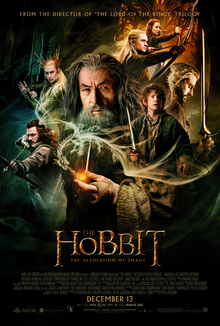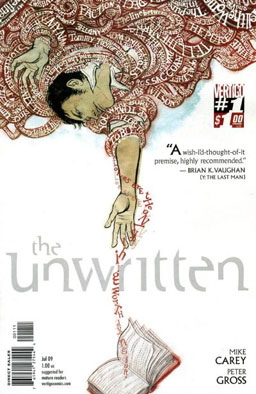The poster doesn't break any new ground, but it lets you know it is a Lord of The Rings movie in the barrel-riding tradition of Peter Jackson's films.
The former is a title that Bilbo grants himself when addressing the dragon Smaug, and refers to an earlier segment of the book (and the movie) where the party manages to escape wood-elf custody by riding downstream in a bunch of emptied wine barrels. In the film's take on this sequence, Legolas and the new character Tauriel leap from dwarf head to dwarf head, committing stylish orc genocide via bow and elven dagger, with with excessively graceful flourishes and occasional assistance from the bobbing dwarves. The whole scene, and the whole movie, are filled with flagrant convenience.
There are two ways to look at this scene.
The first way is to happily tag along for the ride, as the sequence is like a more violent take on a Disneyland roller coaster. If you enjoy the pairing of fantasy trappings with preposterous, contrived logical leaps and elven acrobatics, you are a "Barrel-rider." A reader who appreciates rollicking adventure regardless of plausibility or depth of world building. You stand with Bilbo Baggins.
The second way is to be disgusted at the childish treatment of the most sacred work in the history of western fantasy literature. If you throw your hands up at absurdly cinematic happenstance and stylized combat, and a presentation that utterly ignores Tolkien's legacy as a folklorist, historian, and linguist, you are one of the Ainur (the predecessors to the Valar, or Middle Earth-bound angels who shepherded the races of Elves, Dwarves and Men) described in tremendous detail by Tolkien in the Simarillion (the ponderous cosmology and early history of Middle Earth).
Between these poles, you have the full experience of Tolkien's offerings. Most children will fall in the barrel-rider camp, while most Tolkien devotees can be described as Ainur. I would argue that both of these views are both flawed and virtuous for their own reasons. Barrel-riders are fundamentally childish and frustratingly prone to accept sillines, but they are also naturally predisposed to enjoy adventure in all its forms. They have the most fun. Ainur are pretentious and dry, but they will appreciate Tolkien on a much deeper intellectual level than anybody who experiences Middle Earth exclusively through the movies (or even exclusively through The Hobbit and Lord of the Rings novels). They truly understand Middle Earth.
Both Hobbit films to date, An Unexpected Journey and Desolation of Smaug, err on the side of barrel-riders, and by the numbers, it is the right call. Tolkien wrote The Hobbit for younger audiences, who are more taken with wacky hijinks like hiding in barrels, and having surprisingly detailed conversations with dragons and trolls that ought to be devouring our heroes instead of chatting them up. The problem, is that the Hobbit films must also be built and marketed as PG-13 action movies pitched towards fans of the original trilogy of Lord of the Rings movies.
The Lord of The Rings trilogy remains Tolkien's most popular work because it strikes the perfect balance between his Ainur fans and his barrel-rider fans--on paper at least. But it is undeniable that Peter Jackson's direction, in both The Hobbit films and Lord of The Rings very heavily favors fans of action. It is really hard to fault him for it though, because truth be told, most people are bored to tears by cosmologies and familial lineages. And most Ainur fans will argue that that is how it ought to be. If you cannot endure the songs, and the genealogies, and the almost biblical takes on creation mythology, then you are not worthy of the total joys of Tolkien's work--never mind the fact that The Hobbit was plotted and paced for younger readers.
The problem with The Hobbit films, is that they try to be too many things to too many people. They struggle to remain faithful to the child's story source material, while integrating the far darker-themed appendices of the Lord of the Rings (which are closer in tone to the Simarillion) and the bloody, violent, PG-13 style of that original trilogy. Perhaps the gravest flaws of Desolation, are its concessions to Hollywood focus testing. "Let's make Legolas a major character because he was so popular in The LOTR Trilogy!" and "Let's invent a love interest (Tauriel) from whole cloth because we need more female characters and people won't watch movies if there isn't romance in it." (That said, as shoe-horned romances go, it was written well, if predictably).
If I were in Peter Jackson's position, and had the benefit of hindsight, I would have made three groups of films. The first would greatly resemble the original Lord of the Rings trilogy that we already have. The second would be a much more kid-friendly, almost story-book (and possibly animated) approach to The Hobbit, and the third would be the Ainur-devoted adaptation of both The Lord of the Rings' appendices and the Simarillion, maybe with a few scraps of Unfinished Tails thrown in (maybe as DVD extra content).
I'm getting off-topic though. The question remains: is Desolation worth your holiday movie-going dollars?
If you are a barrel-rider, the answer is an unqualified "Yes!" Let it be known that Bilbo, THE barrel-rider, is the best part of The Hobbit, both in book and movie form. In fact, the preservation of his inescapable heroism may be the greatest triumph of the movie adaptations.He is a reluctant hero who quickly comes into his own as a charming trickster rogue, relying on quick wit, moments of astounding courage, and a reckless willingness to exploit the dubious powers of The One Ring. Even in the source text, he blows Frodo out of the water by actually taking initiative and using The Ring to achieve unqualified good (albeit at the expense of his own sanity in the long game), rather than moping around, relying on Gandalf and his far stronger-willed gardener to bail his ass out of every hardship. It doesn't hurt that Martin Freeman is much stronger actor than Elijah Wood.
If you are an Ainur however, chances are you already feel the series went astray as soon as it hit the silver screen, or at the very least, as soon as they started adapting The Hobbit.
Ultimately, I have to give the nod to the Barrel-riders though. The set-design, CGI, and production values are all top notch. Even without the surreal benefits of 48 frame 3D, the film is visually breathtaking, with a parade of gorgeous sets that set the imagination alight. The musical score is equal parts haunting and inspiring. And while the romantic subplot is forced and contrived, it is about as good as you could hope it would be. Even if you do not appreciate Jackson's tone and direction, the sheer amount of art present in the movie demands a viewing.
I suspect that There and Back Again will follow a similar pattern to this film... but who knows? If this trilogy does well enough, Ainur fans may finally be treated to a faithful adaptation of the Simarillion.
NOTE: My close friend and chief Ainur fan Andrew Nay asserts that any Simarillion movies will not actually be faithful. And given Jackson's barrel-rider sensibilities, that is a fair point.































